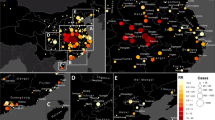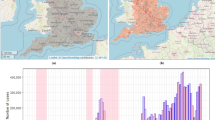Abstract
COVID-19 has ravaged Brazil, and its spread showed spatial heterogeneity. Changes in the environment have been implicated as potential factors involved in COVID-19 transmission. However, considerable research efforts have not elucidated the risk of environmental factors on COVID-19 transmission from the perspective of infectious disease dynamics. The aim of this study is to model the influence of the environment on COVID-19 transmission and to analyze how the socio-ecological factors affecting the probability of virus transmission in 10 states dramatically shifted during the early stages of the epidemic in Brazil. First, this study used a Pearson correlation to analyze the interconnection between COVID-19 morbidity and socio-ecological factors and identified factors with significant correlations as the dominant factors affecting COVID-19 transmission. Then, the time-lag effect of dominant factors on the morbidity of COVID-19 was investigated by constructing a distributed lag nonlinear model and standard two-stage meta-analytic model, and the results were considered in the improved SEIR model. Lastly, a machine learning method was introduced to explore the nonlinear relationship between the environmental propagation probability and socio-ecological factors. By analyzing the impact of environmental factors on virus transmission, it can be found that population mobility directly caused by human activities had a greater impact on virus transmission than temperature and humidity. The heterogeneity of meteorological factors can be accounted for by the diverse climate patterns in Brazil. The improved SEIR model was adopted to explore the interconnection of COVID-19 transmission and the environment, which revealed a new strategy to probe the causal links between them.








Similar content being viewed by others
Data availability
The datasets generated during the current study are available from the corresponding author on reasonable request.
References
Alvares CA, Stape JL, Sentelhas PC et al (2013) Köppen’s climate classification map for Brazil. Meteorol Zeitschrift 22:711–728
Armstrong B (2006) Models for the relationship between ambient temperature and daily mortality. Epidemiology 17:624–631
Bastos SB, Cajueiro DO (2020) Modeling and forecasting the early evolution of the Covid-19 pandemic in Brazil. Sci Rep 10:1–10
Cao S, Feng P, Shi P (2020) Study on the epidemic development of COVID-19 in Hubei province by a modified SEIR model. J Zhejiang Univ 49:178–184
Chien L-C, Yu H-L (2014) Impact of meteorological factors on the spatiotemporal patterns of dengue fever incidence. Environ Int 73:46–56
Cooper I, Mondal A, Antonopoulos CG (2020) A SIR model assumption for the spread of COVID-19 in different communities. Chaos, Solitons Fractals 139:110057
Costello A, Abbas M, Allen A et al (2009) Managing the health effects of climate change: lancet and University College London Institute for Global Health Commission. Lancet 373:1693–1733
Fang X, Ai J, Liu W et al (2019) Epidemiology of infectious diarrhoea and the relationship with etiological and meteorological factors in Jiangsu Province, China. Sci Rep 9:1–9
Fernandes JSC, da Silva RS, Silva AC et al (2021) Altitude conditions seem to determine the evolution of COVID-19 in Brazil. Sci Rep 11:1–12
Ferrante L, Fearnside PM (2020) Brazil threatens Indigenous lands. Science 368:481–482
Franch-Pardo I, Napoletano BM, Rosete-Verges F, Billa L (2020) Spatial analysis and GIS in the study of COVID-19. A review. Sci Total Environ 739:140033
Fu S, Wang B, Zhou J et al (2021) Meteorological factors, governmental responses and COVID-19: evidence from four European countries. Environ Res 194:110596
Gasparrini A, Leone M (2014) Attributable risk from distributed lag models. BMC Med Res Methodol 14:1–8
Grimm V, Mengel F, Schmidt M (2021) Extensions of the SEIR model for the analysis of tailored social distancing and tracing approaches to cope with COVID-19. Sci Rep 11:1–16
Guo X-J, Zhang H, Zeng Y-P (2020) Transmissibility of COVID-19 in 11 major cities in China and its association with temperature and humidity in Beijing, Shanghai, Guangzhou, and Chengdu. Infect Dis Poverty 9:1–13
Gupta S, Raghuwanshi GS, Chanda A (2020) Effect of weather on COVID-19 spread in the US: a prediction model for India in 2020. Sci Total Environ 728:138860
Heidari A, Jafari Navimipour N, Unal M, Toumaj S (2022) Machine learning applications for COVID-19 outbreak management. Neural Comput Appl 34:15313–15348
Jia JS, Lu X, Yuan Y et al (2020) Population flow drives spatio-temporal distribution of COVID-19 in China. Nature 582:389–394
Li MY, Muldowney JS (1995) Global stability for the SEIR model in epidemiology. Math Biosci 125:155–164
Li Z, Wang L, Sun W et al (2013) Identifying high-risk areas of bacillary dysentery and associated meteorological factors in Wuhan, China. Sci Rep 3:1–6
Liang L, Gong P (2017) Climate change and human infectious diseases: a synthesis of research findings from global and spatio-temporal perspectives. Environ Int 103:99–108
Liu F, Wang J, Liu J et al (2020) Predicting and analyzing the COVID-19 epidemic in China: based on SEIRD. LSTM and GWR models. Plos One 15:e0238280
Liu J, Zhou J, Yao J et al (2020b) Impact of meteorological factors on the COVID-19 transmission: a multi-city study in China. Sci Total Environ 726:138513
Loli Piccolomini E, Zama F (2020) Monitoring Italian COVID-19 spread by a forced SEIRD model. PLoS ONE 15:e0237417
Lopes MF (2021) From denial to hope: Brazil deals with a prolonged COVID-19 epidemic course. Nat Immunol 22:256–257
López L, Rodo X (2021) A modified SEIR model to predict the COVID-19 outbreak in Spain and Italy: simulating control scenarios and multi-scale epidemics. Results Phys 21:103746
Ma Y, Zhao Y, Liu J et al (2020) Effects of temperature variation and humidity on the death of COVID-19 in Wuhan. China Sci Total Environ 724:138226
Malki Z, Atlam E-S, Hassanien AE et al (2020) Association between weather data and COVID-19 pandemic predicting mortality rate: machine learning approaches. Chaos, Solitons Fractals 138:110137
Malki Z, Atlam E-S, Ewis A et al (2021) The COVID-19 pandemic: prediction study based on machine learning models. Environ Sci Pollut Res 28:40496–40506
McMichael AJ, Woodruff RE, Hales S (2006) Climate change and human health: present and future risks. Lancet 367:859–869
Menda K, Laird L, Kochenderfer MJ, Caceres RS (2021) Explaining COVID-19 outbreaks with reactive SEIRD models. Sci Rep 11:1–12
Mwalili S, Kimathi M, Ojiambo V et al (2020) SEIR model for COVID-19 dynamics incorporating the environment and social distancing. BMC Res Notes 13:1–5
Nottmeyer LN, Sera F (2021) Influence of temperature, and of relative and absolute humidity on COVID-19 incidence in England-a multi-city time-series study. Environ Res 196:110977
Nouvellet P, Bhatia S, Cori A et al (2021) Reduction in mobility and COVID-19 transmission. Nat Commun 12:1–9
Ozyigit A (2020) Understanding Covid-19 transmission: the effect of temperature and health behavior on transmission rates. Infect Dis Heal 25:233–238
Patel D, Kher V, Desai B et al (2021) Machine learning based predictors for COVID-19 disease severity. Sci Rep 11:4673
Pinto Neto O, Kennedy DM, Reis JC et al (2021) Mathematical model of COVID-19 intervention scenarios for São Paulo—Brazil. Nat Commun 12:1–13
Ram V, Schaposnik LP (2021) A modified age-structured SIR model for COVID-19 type viruses. Sci Rep 11:15194. https://doi.org/10.1038/s41598-021-94609-3
Runkle JD, Sugg MM, Leeper RD et al (2020) Short-term effects of specific humidity and temperature on COVID-19 morbidity in select US cities. Sci Total Environ 740:140093
Schwartz J (2000) The distributed lag between air pollution and daily deaths. Epidemiology 11:320–326
Sera F, Armstrong B, Blangiardo M, Gasparrini A (2019) An extended mixed-effects framework for meta-analysis. Stat Med 38:5429–5444
Sera F, Armstrong B, Abbott S et al (2021) A cross-sectional analysis of meteorological factors and SARS-CoV-2 transmission in 409 cities across 26 countries. Nat Commun 12:5968. https://doi.org/10.1038/s41467-021-25914-8
Shi P, Dong Y, Yan H et al (2020) Impact of temperature on the dynamics of the COVID-19 outbreak in China. Sci Total Environ 728:138890
Sujath R, Chatterjee JM, Hassanien AE (2020) A machine learning forecasting model for COVID-19 pandemic in India. Stoch Environ Res Risk Assess 34:959–972
Tang S, Wang C, Nie J et al (2021) EDL-COVID: ensemble deep learning for COVID-19 case detection from chest x-ray images. IEEE Trans Ind Inform 17:6539–6549
Tiwari A, Dadhania AV, Ragunathrao VAB, Oliveira ERA (2021) Using machine learning to develop a novel COVID-19 Vulnerability Index (C19VI). Sci Total Environ 773:145650
Ujiie M, Tsuzuki S, Ohmagari N (2020) Effect of temperature on the infectivity of COVID-19. Int J Infect Dis 95:301–303
Vale MM, Berenguer E, de Menezes MA et al (2021) The COVID-19 pandemic as an opportunity to weaken environmental protection in Brazil. Biol Conserv 255:108994
Valente DS, Zanella RK (2020) Brazil’s COVID-19 response. Lancet 396:e32
Watts N, Adger WN, Agnolucci P et al (2015) Health and climate change: policy responses to protect public health. Lancet 386:1861–1914
Wei YY, Lu ZZ, Du ZC et al (2020) Fitting and forecasting the trend of COVID-19 by SEIR (+ CAQ) dynamic model. Zhonghua Liu Xing Bing Xue Za Zhi= Zhonghua Liuxingbingxue Zazhi 41:470–475
Wu JT, Leung K, Leung GM (2020) Nowcasting and forecasting the potential domestic and international spread of the 2019-nCoV outbreak originating in Wuhan, China: a modelling study. Lancet 395:689–697
Xiao Y, He L, Chen Y et al (2018) The influence of meteorological factors on tuberculosis incidence in Southwest China from 2006 to 2015. Sci Rep 8:1–8
Funding
This research was funded by the National Key Research and Development Program of China (2021YFC0863400) and Tang Scholar Program (K. Jia is a Tang Scholar of Beijing Normal University).
Author information
Authors and Affiliations
Contributions
Conceptualization: Kun Jia, Wenwu Zhao; methodology: Jie Li, Kun Jia; formal analysis and investigation: Jie Li, Kun Jia, Bo Yuan; writing — original draft preparation: Jie Li; writing — review and editing: Kun Jia, Wenwu Zhao, Bo Yuan, Yanxu Liu; funding acquisition: Kun Jia, Wenwu Zhao; resources: Jie Li, Bo Yuan, Kun Jia, Wenwu Zhao; supervision: Kun Jia, Wenwu Zhao.
Corresponding author
Ethics declarations
Competing interests
The authors declare no known competing interests.
Supplementary information
Below is the link to the electronic supplementary material.
Rights and permissions
Springer Nature or its licensor (e.g. a society or other partner) holds exclusive rights to this article under a publishing agreement with the author(s) or other rightsholder(s); author self-archiving of the accepted manuscript version of this article is solely governed by the terms of such publishing agreement and applicable law.
About this article
Cite this article
Li, J., Jia, K., Zhao, W. et al. Natural and socio-environmental factors contribute to the transmissibility of COVID-19: evidence from an improved SEIR model. Int J Biometeorol 67, 1789–1802 (2023). https://doi.org/10.1007/s00484-023-02539-8
Received:
Revised:
Accepted:
Published:
Issue Date:
DOI: https://doi.org/10.1007/s00484-023-02539-8




